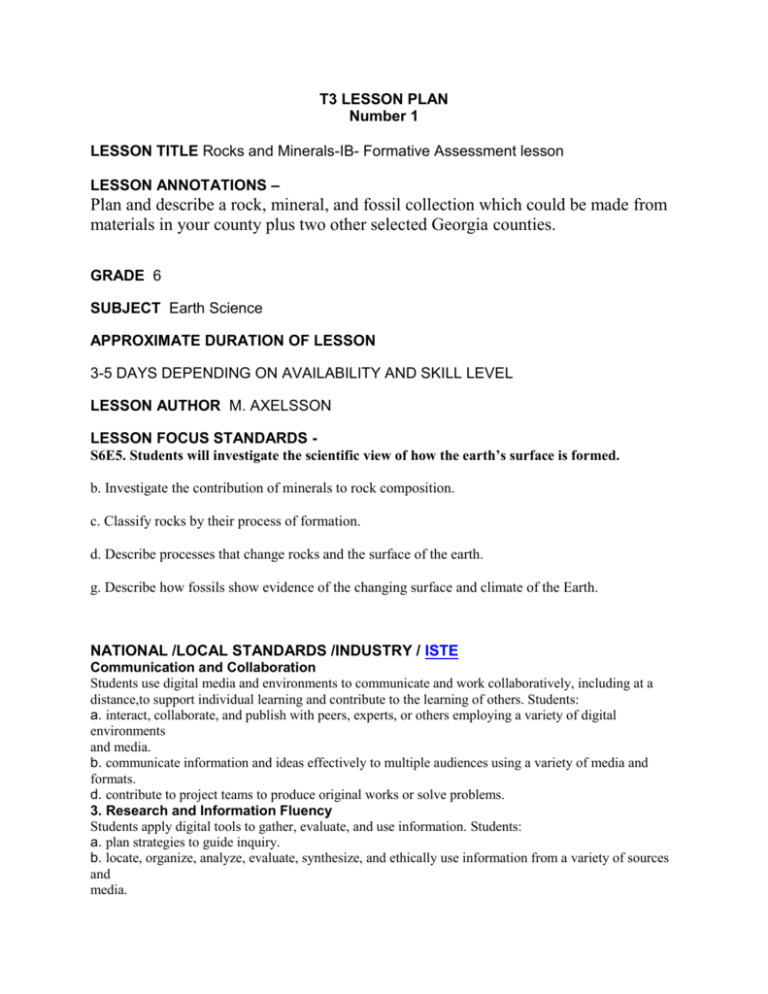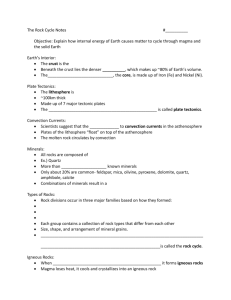lesson1 Mary Axelsson
advertisement

T3 LESSON PLAN Number 1 LESSON TITLE Rocks and Minerals-IB- Formative Assessment lesson LESSON ANNOTATIONS – Plan and describe a rock, mineral, and fossil collection which could be made from materials in your county plus two other selected Georgia counties. GRADE 6 SUBJECT Earth Science APPROXIMATE DURATION OF LESSON 3-5 DAYS DEPENDING ON AVAILABILITY AND SKILL LEVEL LESSON AUTHOR M. AXELSSON LESSON FOCUS STANDARDS S6E5. Students will investigate the scientific view of how the earth’s surface is formed. b. Investigate the contribution of minerals to rock composition. c. Classify rocks by their process of formation. d. Describe processes that change rocks and the surface of the earth. g. Describe how fossils show evidence of the changing surface and climate of the Earth. NATIONAL /LOCAL STANDARDS /INDUSTRY / ISTE Communication and Collaboration Students use digital media and environments to communicate and work collaboratively, including at a distance,to support individual learning and contribute to the learning of others. Students: a. interact, collaborate, and publish with peers, experts, or others employing a variety of digital environments and media. b. communicate information and ideas effectively to multiple audiences using a variety of media and formats. d. contribute to project teams to produce original works or solve problems. 3. Research and Information Fluency Students apply digital tools to gather, evaluate, and use information. Students: a. plan strategies to guide inquiry. b. locate, organize, analyze, evaluate, synthesize, and ethically use information from a variety of sources and media. c. evaluate and select information sources and digital tools based on the appropriateness to specific tasks. d. process data and report results. 4. Critical Thinking, Problem Solving, and Decision Making Students use critical thinking skills to plan and conduct research, manage projects, solve problems, and makeinformed decisions using appropriate digital tools and resources. Students: b. plan and manage activities to develop a solution or complete a project. c. collect and analyze data to identify solutions and/or make informed decisions. d. use multiple processes and diverse perspectives to explore alternative solutions. ESSENTIAL QUESTION(S) – How are rocks, minerals, and fossils formed and classified throughout the world and in your state? PRE-REQUISITE KNOWLEDGE & SKILLS/CURRENT LESSON KNOWLEDGE & SKILLS - students should know the following information as well as how to use glogster or epals to create a page for the formative assessment. Sedimentary, igneous, metamorphic, rock composition, mineral formation, pressure, rock cycle, • Minerals can be identified by their physical properties. • Igneous rocks are dominated by silicate minerals. • Rocks are composed of minerals. Minerals are the building blocks of rocks. • The rock cycle explains how one rock type can be transformed into another. This process is continuing today. • Magma cools and crystallizes to form igneous rock. • Igneous rock undergoes weathering (or breakdown) to form sediment. The sediment is transported and deposited s or in the deep sea). • Usually after burial, the deposited sediment undergoes lithification (the processes that turn it into a rock). This inc • If the sedimentary rock is buried deep in the crust under more and more sediment, often due to plate tectonic move metamorphism to occur. This transforms the sedimentary rock into a metamorphic rock. • As the metamorphic rock is buried more deeply, temperatures and pressures continue to rise. If the temperature be undergoes melting. The molten rock is called magma. This completes the cycle. • Any rock type can undergo weathering to form sediment. Igneous, metamorphic and sedimentary rocks undergo w • Igneous rocks can undergo metamorphism (as a result of heat and pressure) to form metamorphic rocks. ASSESSMENTS: This is a formative/ cumulative assessment for Rocks and minerals. The following IB rubrics will be used to assess the final project. Criterion B- Communication in science-maximum 6 points Criterion C- Knowledge and Understanding of science- maximum 6 points For each assessed criterion a number of band descriptors are defined. These describe the range of achievement levels with the lowest represented as 0. ATTACH ASSESSMENT(OPTIONAL) – INSTRUCTIONAL PLANNING – Teacher will assist students when needed, with technology and research. Students will create a page in glogster, epals blog or wiki. This page should contain the following information. Goal: Plan and describe a rock, mineral, and fossil collection which could be made from materials in your county plus two other selected Georgia counties. Role: A middle school student called on to assist in developing a collection. Audience: IB students using epals or glogster, and any other students that need information about the rocks found in GA, USA. Assume they do not know anything about this topic. Situation: Your teacher needs a class set of teaching specimens of 8 different rock types (including sedimentary, igneous, and metamorphic examples), 4 fossils representing a variety of ages and environments of origin, and 1 nonrenewable energy resource. Using the Lawton (1977) Geologic Map of Georgia, you will determine the extent to which these needs can be supplied from your own county. Then identify two other counties from which samples would allow you to complete the collection. Product: The glogster page, Epals blog or wiki should contain the following information Provide a written description and picture/video of the items in the proposed collection and the county of origin of each. For each rock, provide written information and pictures/videos on the minerals that make it up, as well as how it formed as an igneous, sedimentary, or metamorphic rock. For each fossil, include a picture/video, tell how old it is and in what kind of environment the organism lived. For the energy resource, explain how it formed and why it is considered nonrenewable. MATERIALS AND EQUIPMENT – Copy of the Lawton (1977) Geologic Map of Georgia Access to Laptops or computer lab with internet access. Samples of different types of rocks, minerals and Fossils found in GA. Field guides of rocks, minerals and fossils WEB RESOURCES – Media and research information about rocks, minerals, fossils and mining around the world. Students can also contact students using epals to find information about minerals, rocks and fossils around the state and world. NASA earth science for kids. Provides information about all earth processes. . http://kids.earth.nasa.gov/ Rocks for Kids. This site lists many websites and contains information about rocks and minerals http://www.rocksforkids.com/RFK/TableofContents.html Rock Hounds – A fun and complete guide to rocks and minerals http://www.fi.edu/fellows/fellow1/oct98/index2.html USGS- provides rock and mineral information by state http://minerals.usgs.gov/minerals/pubs/state/ga.html Virtual Fossil museum- indentifies fossils by geologic time http://fossils.valdosta.edu/index.html Paleontology Portal provides information by state of Fossils, rocks and minerals http://www.paleoportal.org/index.php?globalnav=time_space&sectionnav=map 21ST CENTURY TECHNOLOGY: Select all technology applications used in this lesson. Double click on the box and select the check option to make your selection. Slideshow Interactive Whiteboard Student Response System Graphing Software Email- Epals, communication with students and classes around the world Blog Wiki Videos Images Websites Other Type any other technology used in this area. Notes/Reflections Remember this is an end of unit Formative assessment lesson. The information and processes must be taught prior to this lesson for it to be successful.








